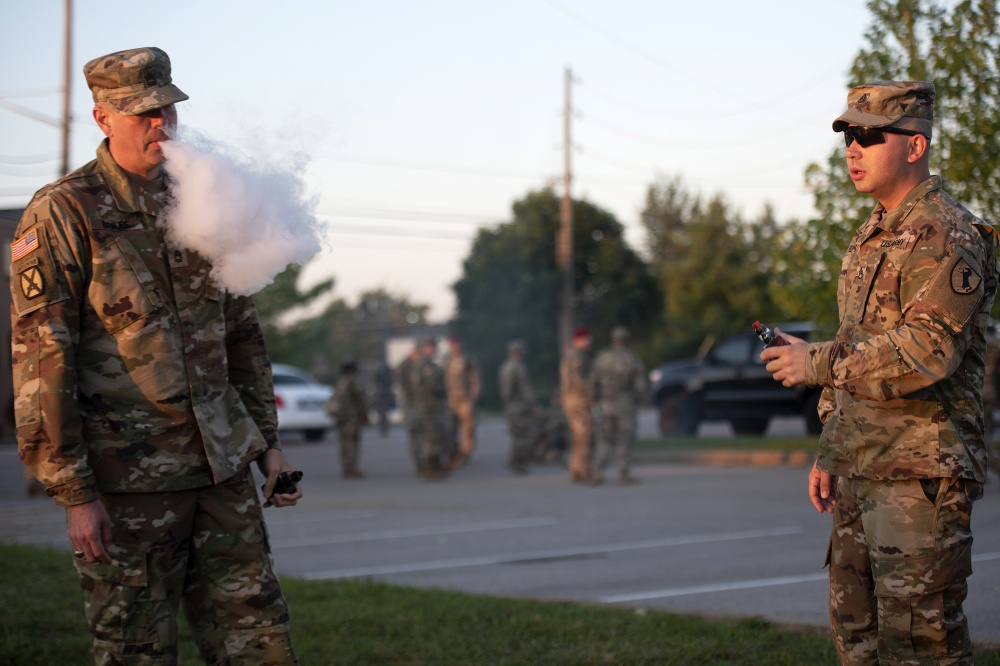Health Officials Warn of Vaping Dangers as Death, Illness toll Rises Across Nation
4 min read
FORT KNOX, KY, UNITED STATES
Story by Eric Pilgrim
Fort Knox
The nation’s leading health officials at the Centers for Disease Control and Federal Drug Administration have taken notice to what many are describing as a growing epidemic of vaping-related deaths and illnesses.
One death involved an unidentified Oregon resident, who was rushed to the hospital with acute respiratory illness. After his death, health officials said they suspected the illness was tied to a vaping device.
“The individual’s symptoms were consistent with those of more than 200 similar cases in a national cluster of respiratory illness, mostly affecting teenagers and young adults, in at least 25 states,” wrote Oregon Health Authority officials in a news release.
Fort Knox health officials said links between some lung diseases and vaping devices are just beginning to surface within the health community, leaving many scrambling for answers.
“We don’t know what’s in those things, and the more we’re learning, the more serious it’s becoming,” said Dr. James Stephens, chief of the Department of Preventive Medicine at Ireland Army Health Clinic. “There’s not a lot of regulation of any of the vaping products right now.”
Stephens and Capt. Celeste Singletary, chief of Army Public Health Nursing at IRAHC, said vaping actually began several years ago as a method for smoking cessation.
“When they first came out, it was basically nicotine and water. That was it,” said Stephens. “When [they] started adding everything, that’s when all the problems started.”
With the recent deregulation of CBD oils and growing popularity among everyone from movie stars to teens, vaping products typically fall into one of three categories: nicotine and menthol; various fruit flavors; and, CBD oils. There are growing concerns with every aspect of vaping — everything from what’s in the oils to what’s in the huge plume of steam that is commonly called the cloud.
“Polyethylene glycol and glycerin are types of things we add to a lot of foods and makeups; it’s what gives you that nice cloud,” said Stephens. “You can eat them, but inhalation causes a lot of inflammation and damage. What I put in my stomach is totally different than what my lungs will allow, and a lot of the vaper is water, a lot of it is oils, a lot of it is polyethylene glycol; a lot it is we have no clue.”
So far, there have not been a lot of cases of lung disease at Fort Knox linked to vaping, according to Stephens, but that doesn’t mean the issues aren’t here.
“I never really saw a lot of people coming in and saying, ‘I’ve been vaping and this is causing a problem,’ and that’s part of the problem,” said Stephens. “People will come in with a respiratory illness — all these nondescript symptoms. What it comes down to is, what is the cause of it?
“Now that we’ve had over 200 cases in 25 states, everybody’s looking at it.”
Stephens said British health officials came to the United States to look at it a few years ago. They studied 75 different brands from vaping companies and discovered that 25% of them contained bacterial components, and approximately 61 of the 75 brands carried pieces of fungal components.
“As a result, they are much more stringent about what they will allow over there,” said Stephens.
Stephens said many U.S. health officials are focusing on those bacterial and fungal infections to see if they’re linked to vaping.
“That’s one of the things that we’re looking at with the gentleman in Illinois that just died,” said Stephens.
The Illinois man had reported vaping with an e-cigarette after being admitted to a hospital last month, according to an Aug. 24 article in USA Today. Officials from the Illinois Department of Health said the man died after being admitted for severe respiratory illness.
Stephens explained that glucans can be good for people in some instances, but the presence of beta-d-glucan is a red flag.
“Beta-d-glucan is what we look for when we look for fungal infections, and that’s what they’re finding in a lot of these vape products; especially the fruity ones,” said Stephens.
Singletary recently moved here from Fort Bragg, North Carolina, where she found herself at ground zero of a number of cases that had surfaced among Soldiers and civilian employees in the spring of 2018. According to a Feb. 15, 2018 story in The Fayetteville Observer, more than 24 Soldiers had been treated at Womack Army Medical Center “for symptoms that range from headaches to seizures, officials said.”
The number of cases grew to approximately 60 by April of that year, leading health officials to release a public health alert (https://phc.amedd.army.mil/topics/healthyliving/tfl/Pages/VapeOils.aspx).
“I was the one tracking all of them, and interviewing them,” said Singletary. “We took the information firsthand from the patients and there was a total of 38 that were affected resulting in seven deaths, one a Marine.”
Of the 38, six were civilian Family members.
Fort Bragg officials started an education campaign soon after because of the sharp rise in deaths and illnesses among the Soldiers. Singletary recommends an active education program be started here, as well, urging units and organizations to get the word out about the dangers of vaping:
“You’re literally playing Russian roulette with your life.”





